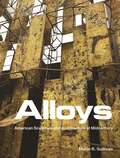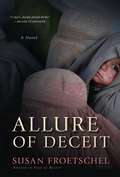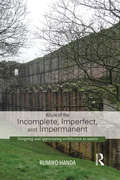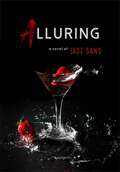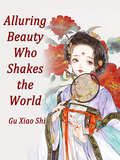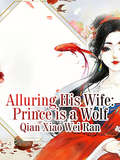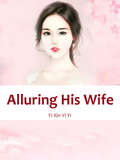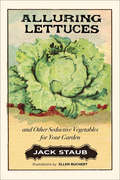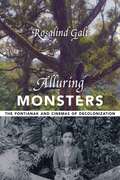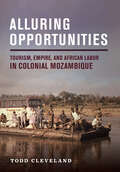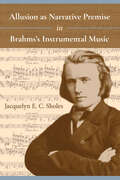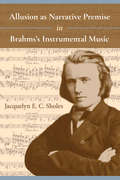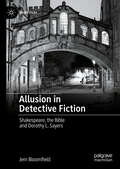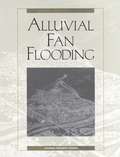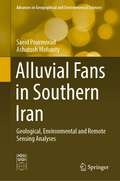- Table View
- List View
Alloys: American Sculpture and Architecture at Midcentury
by Marin R. SullivanA new look at the interrelationship of architecture and sculpture during one of the richest periods of American modern designAlloys looks at a unique period of synergy and exchange in the postwar United States, when sculpture profoundly shaped architecture, and vice versa. Leading architects such as Gordon Bunshaft and Eero Saarinen turned to sculptors including Harry Bertoia, Alexander Calder, Richard Lippold, and Isamu Noguchi to produce site-determined, large-scale sculptures tailored for their buildings’ highly visible and well-traversed threshold spaces. The parameters of these spaces—atriums, lobbies, plazas, and entryways—led to various designs like sculptural walls, ceilings, and screens that not only embraced new industrial materials and processes, but also demonstrated art’s ability to merge with lived architectural spaces.Marin Sullivan argues that these sculptural commissions represent an alternate history of midcentury American art. Rather than singular masterworks by lone geniuses, some of the era’s most notable spaces—Philip Johnson’s Four Seasons Restaurant in Mies van der Rohe’s Seagram Building, Max Abramovitz’s Philharmonic Hall at Lincoln Center, and Pietro Belluschi and Walter Gropius’s Pan Am Building—would be diminished without the collaborative efforts of architects and artists. At the same time, the artistic creations within these spaces could not exist anywhere else. Sullivan shows that the principle of synergy provides an ideal framework to assess this pronounced relationship between sculpture and architecture. She also explores the afterlives of these postwar commissions in the decades since their construction.A fresh consideration of sculpture’s relationship to architectural design and functionality following World War II, Alloys highlights the affinities between the two fields and the ways their connections remain with us today.
Allstate Corporation, 2007-2013
by John R. Wells Galen DanskinAfter five years of global financial crises and natural catastrophes, Allstate, the USA's number two property and casualty insurer, seemed to be on the mend. It had been a tough ride for Thomas Wilson who had taken over as CEO on January 1, 2007 and vowed to "reinvent protection and retirement for the consumer." Soon after this statement, combination of exogenous shocks and fierce competition had driven the whole industry into underwriting losses. Meanwhile, Allstate continued to lose market share to GEICO and Progressive as it struggled to build its direct sales business in the face of opposition from its tied-agent distribution system. During the May 2011 Annual General Meeting (AGM), 31% of shareholders voted against Wilson's reappointment, the highest "no" vote for any CEO in the Standard & Poor's 500. Many speculated that he would not last long. To help boost direct sales, in October 2011, Wilson completed the acquisition of Esurance, a direct online specialist with a 2% share of online sales. In the next six months, Allstate's stock price rose 45%, buoyed by Wilson's promise that return on equity would reach 13% by 2014. At the May 2012 AGM, Wilson's support from shareholders surged to 97%. By the end of 2012, revenues were up 2% to $33.3 billion while operating profits surged 168% to $3.6 billion. With renewed support, Wilson pondered on what else he might do to ward off the challenges from GEICO and Progressive.
Alltech
by Natalie Kindred David E. BellAlltech was a Lexington, Kentucky–based producer of supplements for animal feed, with revenues of over $2 billion (projected to reach $3 billion in 2018), sales in 120 countries, 5,000 employees, and 100 manufacturing plants worldwide. For nearly four decades, Alltech had been defined by its focus on innovation and marketing as well as the entrepreneurial spirit and vision of its founder, Dr. Pearse Lyons, who remained intimately involved in company operations and in managing relationships with key customers. This case finds Alltech in the midst of a new growth strategy—downstream integration, specifically buying up feed companies—which marked a stark departure from the company’s longtime emphasis on organic growth. The decision to buy feed companies had been controversial within Alltech: feed was a low-margin, rather traditional commodity business, while Alltech earned relatively high margins on products rooted in science and innovation. However, Lyons believed downstream integration would allow Alltech to better communicate with its end customers (farmers), increase sales of its supplements, and help protect the firm from industry dynamics such as consolidation and cost pressure. Was he right, or should Alltech take a different approach?
Alltech...naturally
by David E. Bell Mary ShelmanEntrepreneur Pearse Lyons had built Alltech into the fastest growing company in the global animal health industry through innovative technology, creative marketing, and strong branding. Sel-Plex, a proprietary Alltech product, had shown important health benefits for animals and humans. Although numerous branded selenium-enriched products were being sold in supermarkets around the world, the company's current business model (selling Sel-Plex as an ingredient) did not allow it to participate in the value created. Lyons and Alltech's directors must choose between three different options for Sel-Plex, which include continuing with the current strategy, partnering with animal producers, or marketing Sel-Plex directly to consumers in tablet form.
Allure of Deceit
by Susan FroetschelA young inventor and his wife are killed in a terrorist attack--leaving behind a will that surprises friends and parents by directing a vast fortune toward charities in the developing world. On the ground in Afghanistan, international charities rapidly search for Afghan partners to compete for the attention of the new foundation, focusing their efforts on two particular women in the village of Laashekoh: a young mother who might have been wrongly imprisoned for her role in helping to run a child-trafficking ring; and an older, educated woman who has a reputation for providing reproductive healthcare--including abortions.Meanwhile, most Laashekoh villagers do not want Western charity and are astounded to be regarded as potential recipients; they are self-sufficient and see no need for outside intervention in village concerns. But when a group of orphanage workers visiting the village goes missing, foul play is immediately suspected and the villagers face tough questions.As Afghans and Westerners work to uncover the truth, the reputations of charity workers, potential beneficiaries, and locals in Laashekoh are called into question. The stakes are high, the sums of money are huge, and cultures clash. All these are motivations for fraud and murder in Allure of Deceit.From the Trade Paperback edition.
Allure of the Incomplete, Imperfect, and Impermanent: Designing and Appreciating Architecture as Nature
by Rumiko HandaArchitects have long operated based on the assumption that a building is 'complete' once construction has finished. Striving to create a perfect building, they wish for it to stay in its original state indefinitely, viewing any subsequent alterations as unintended effects or the results of degeneration. The ideal is for a piece of architecture to remain permanently perfect and complete. This contrasts sharply with reality where changes take place as people move in, requirements change, events happen, and building materials are subject to wear and tear. Rumiko Handa argues it is time to correct this imbalance. Using examples ranging from the Roman Coliseum to Japanese tea rooms, she draws attention to an area that is usually ignored: the allure of incomplete, imperfect and impermanent architecture. By focusing on what happens to buildings after they are ‘complete’, she shows that the ‘afterlife’ is in fact the very ‘life’ of a building. However, the book goes beyond theoretical debate. Addressing professionals as well as architecture students and educators, it persuades architects of the necessity to anticipate possible future changes and to incorporate these into their original designs.
Alluring
by Jade SandBruno could be considered a successful man. Graduated, working, dating an amazing girl and was the owner of a large apartment, he had nothing to complain about but for the financial crisis. To maintain the expensive apartment, he decides to share it with four other boys, all students and workers. Eric needed a room downtown and was in a hurry. It could be shared. It could even be the servicers room in the back of Bruno's apartment, although the lack of ventilation made his allergies worse. Sensitive and mysterious, he begins to arouse different feelings in the people around him. Gay romance.
Alluring Aroma FYBA - RTMNU
by Kapil Singhel Madhavi Moharil Ajiet JachakThis book consists of a wide range of English prose and poetry, apart from primary grammar, and attempts to enhance the vocabulary and writing skills of the learners. Writings with themes from different walks of life have been carefully collected together to present a conglomerate picture that would motivate the imaginative faculty and sharpen the creativity of students. The other aim of this course is to improve the communication skills of undergraduate students at large. Through exercises that are given at the end of every chapter, we aim to achieve the specific objectives and learning outcomes for which the content has been planned and developed. We seek your feedback as to our success in presenting the text as per student needs and requirements.
Alluring Beauty Who Shakes the World: Volume 1 (Volume 1 #1)
by Gu XiaoShian imperial edict said that the young miss of the feng family had been married off to the unparalleled beauty of prince jing he had thought that he would be able to run away after completing his goal but now he had fallen into a pit once more your highness you said that you won't touch me a certain woman stepped back that was because you were too young so it wasn't convenient for you prince you are a gentleman if you say something you will not be able to keep up with it yeah so i definitely can't let you go he had clearly said that he would succeed and retreat the female looked at the big tailed wolf that was slowly approaching and wanted to cry but no tears came out
Alluring Beauty Who Shakes the World: Volume 2 (Volume 2 #2)
by Gu XiaoShian imperial edict said that the young miss of the feng family had been married off to the unparalleled beauty of prince jing he had thought that he would be able to run away after completing his goal but now he had fallen into a pit once more your highness you said that you won't touch me a certain woman stepped back that was because you were too young so it wasn't convenient for you prince you are a gentleman if you say something you will not be able to keep up with it yeah so i definitely can't let you go he had clearly said that he would succeed and retreat the female looked at the big tailed wolf that was slowly approaching and wanted to cry but no tears came out
Alluring Beauty Who Shakes the World: Volume 3 (Volume 3 #3)
by Gu XiaoShian imperial edict said that the young miss of the feng family had been married off to the unparalleled beauty of prince jing he had thought that he would be able to run away after completing his goal but now he had fallen into a pit once more your highness you said that you won't touch me a certain woman stepped back that was because you were too young so it wasn't convenient for you prince you are a gentleman if you say something you will not be able to keep up with it yeah so i definitely can't let you go he had clearly said that he would succeed and retreat the female looked at the big tailed wolf that was slowly approaching and wanted to cry but no tears came out
Alluring Beauty Who Shakes the World: Volume 4 (Volume 4 #4)
by Gu XiaoShian imperial edict said that the young miss of the feng family had been married off to the unparalleled beauty of prince jing he had thought that he would be able to run away after completing his goal but now he had fallen into a pit once more your highness you said that you won't touch me a certain woman stepped back that was because you were too young so it wasn't convenient for you prince you are a gentleman if you say something you will not be able to keep up with it yeah so i definitely can't let you go he had clearly said that he would succeed and retreat the female looked at the big tailed wolf that was slowly approaching and wanted to cry but no tears came out
Alluring His Wife: Volume 1 (Volume 1 #1)
by Qian XiaoweiranShe was a famous surgeon of the modern age, and once transmigrated, she became a mad woman imprisoned in an iron cage. In her previous life, she had risked her life to save the peerless Southern Hill's King. When the bridge of flowers was carried into the palace, her older sister had used a sword to wound her and replaced her. In this life, the Southern Hill's Royal Concubine only wanted to relieve Princess Rou of her boredom, as she was stuffed into the bridal bridge and became the substitute for her second sister.
Alluring His Wife: Volume 1 (Volume 1 #1)
by Yi XinyiyiHe was the lover she had gone all out to pursue, the husband she had decided to take revenge on. Everyone in A City knew that Shi Wenxi was Lu Shaoming's favorite wife, because he had nearly lost his life laughing at her. She was the only one who knew how cruel he was. Five years ago, he had personally sent her to prison to protect another woman. She was just a double for her. Later, Shi Wenxi was tired and decided to let go, but Lu Shaoming wasn't willing to let her go. Shi Wenxi, you dare to run after provoking me? " It turned out that the day of their mutual love and killing had only just begun …
Alluring His Wife: Volume 2 (Volume 2 #2)
by Qian XiaoweiranShe was a famous surgeon of the modern age, and once transmigrated, she became a mad woman imprisoned in an iron cage. In her previous life, she had risked her life to save the peerless Southern Hill's King. When the bridge of flowers was carried into the palace, her older sister had used a sword to wound her and replaced her. In this life, the Southern Hill's Royal Concubine only wanted to relieve Princess Rou of her boredom, as she was stuffed into the bridal bridge and became the substitute for her second sister.
Alluring Lettuces: And Other Seductive Vegetables for Your Garden
by Jack StaubA richly illustrated guide to unique and gorgeous vegetable varieties for your garden. Seventy-five unusual and eminently beautiful vegetables are profiled in this charming book by expert gardener and garden designer Jack Staub. Within these pages, you&’ll discover produce not likely found at the supermarket, including the Asparagus Bean, Chinese Rat Tail Radish, Green Zebra Tomato, and Turkish Orange Eggplant. Staub includes history, stories, and lore surrounding the plants, as well as instructions for growing them outdoors or indoors in containers. Whether you're an avid gardener or a dabbler, you'll love the flowery descriptions and original art showcasing these vegetables that are perfect for your garden.
Alluring Monsters: The Pontianak and Cinemas of Decolonization (Film and Culture Series)
by Rosalind GaltThe pontianak, a terrifying female vampire ghost, is a powerful figure in Malay cultures, as loved and feared in Southeast Asia as Dracula is in the West. In animist tradition, she is a woman who has died in childbirth, and her vengeful return upsets gender norms and social hierarchies. The pontianak first appeared on screen in late colonial Singapore in a series of popular films that combine indigenous animism and transnational production with the cultural and political force of the horror genre.In Alluring Monsters, Rosalind Galt explores how and why the pontianak found new life in postcolonial Southeast Asian film and society. She argues that the figure speaks to a series of intersecting anxieties: about femininity and modernity, globalization and indigeneity, racial and national identities, the relationship of Islam to animism, and heritage and environmental destruction. The pontianak offers abundant feminist potential, but her disruptive gender politics also unsettle queer and feminist film theories by putting them in dialogue with Malay epistemologies. Reading the pontianak as a precolonial figure of disturbance within postcolonial cultures, Galt reveals the importance of cinema to histories and theories of decolonization. From the horror films made by Cathay Keris and Shaw Studios in the 1950s and 1960s to contemporary film, television, art, and fiction in Malaysia and Singapore, the pontianak in all her media forms sheds light on how postcolonial identities are both developed and contested. In tracing the entanglements of Malay feminist animisms with postcolonial visual cultures, Alluring Monsters reveals how a “pontianak theory” can reshape understandings of anticolonial aesthetics and world cinema.
Alluring Opportunities: Tourism, Empire, and African Labor in Colonial Mozambique (Histories and Cultures of Tourism)
by Todd ClevelandAlluring Opportunities examines the lives of African laborers in the tourism industry in the Portuguese colony of Mozambique and the social ascension that many of these workers achieved in spite of demanding conditions. From the origin of the colonial period until its end in 1975, the tourism industry developed on the backs of these laborers and ultimately became an important source of foreign exchange for Portugal.Todd Cleveland explores the daily experiences of local tourism workers in the genesis and expansion of this vital industry with an analytical utility that transcends Africa's borders by complicating the narrative established and reinforced by an expansive body of literature that stresses the exploitation of indigenous tourism workers. He argues that just as foreign tourists embraced the opportunity to travel to various locations in Mozambique, so too did many Indigenous laborers seize opportunities for employment in the tourism industry in an effort to realize social mobility via both the steady wages that they earned and their daily interactions with sojourning clientele. Alluring Opportunities reconstructs these workers' lives, highlighting their critical contributions to the local industry, while also prompting a reconsideration of Indigenous labor and social mobility in colonial Africa. As a result, Cleveland reveals new ways of thinking, more broadly, about the ways that tourism shapes processes of empire, interracial interactions, and power relations.
Alluring Wife: Volume 1 (Volume 1 #1)
by Meng DeHe had a house, a car, and a school beauty's wife. Xiao Yang was practically a winner in life, but his wife had actually secretly carried him on her back …
Allusion as Narrative Premise in Brahms's Instrumental Music (Musical Meaning And Interpretation Ser.)
by Jacquelyn E. SholesA musicologist offers a fresh look at how Brahms used the inspiration of earlier composers in his own instrumental works.As Jacquelyn E. C. Sholes reveals in this study, an essential aspect of Johannes Brahms’s art was the canny use of musical references to the works of others. By analyzing newly identified allusions alongside previously known musical references in works such as the B-Major Piano Trio, the D-Major Serenade, the First Piano Concerto, and the Fourth Symphony, Sholes demonstrates how a historical reference in one movement can resonate meaningfully, musically, and dramatically with material in other movements in ways not previously recognized.Brahms masterfully wove such references into broad, movement-spanning narratives. Sholes argues that these narratives served as expressive outlets for his complicated attitudes toward the material to which he alludes. Ultimately, Brahms’s music reveals both the inspiration and the burden that established masters such as Domenico Scarlatti, J. S. Bach, Haydn, Mozart, Schubert, Schumann, Wagner, and especially Beethoven represented for him as he struggled to establish his own artistic voice and place in musical history.
Allusion as Narrative Premise in Brahms’s Instrumental Music (Musical Meaning and Interpretation)
by Jacquelyn E. SholesWho inspired Johannes Brahms in his art of writing music? In this book, Jacquelyn E. C. Sholes provides a fresh look at the ways in which Brahms employed musical references to works of earlier composers in his own instrumental music. By analyzing newly identified allusions alongside previously known musical references in works such as the B-Major Piano Trio, the D-Major Serenade, the First Piano Concerto, and the Fourth Symphony, among others, Sholes demonstrates how a historical reference in one movement of a work seems to resonate meaningfully, musically, and dramatically with material in other movements in ways not previously recognized. She highlights Brahms's ability to weave such references into broad, movement-spanning narratives, arguing that these narratives served as expressive outlets for his complicated, sometimes conflicted, attitudes toward the material to which he alludes. Ultimately, Brahms's music reveals both the inspiration and the burden that established masters such as Domenico Scarlatti, J. S. Bach, Haydn, Mozart, Schubert, Schumann, Wagner, and especially Beethoven represented for him as he struggled to emerge with his own artistic voice and to define and secure his unique position in music history.
Allusion in Detective Fiction: Shakespeare, the Bible and Dorothy L. Sayers (Crime Files)
by Jem BloomfieldThis study argues that allusion is a central part of classic British detective fiction. It demonstrates the fraught status of Shakespeare and the Bible during the Golden Age of the British detective novel, and the cultural currents which novelists navigated whilst alluding to them. The first part traces the complex web of allusions to Shakespeare and the Bible which appear in the novels of Agatha Christie and Dorothy L. Sayers, examining the meanings these allusions produce. The second part explores the way in which Sayers’ own collection of detective novels became a canon, on which later novelists exercised those same allusive practices. It studies allusions to Sayers’ novels throughout the twentieth century and into the twenty-first, from Gladys Mitchell and P.D. James to Reginald Hill and Sujata Massey. This study reveals allusion as a shaping force at the origin of the classic British detective novel, and a continuing element in its identity.
Alluvial Fan Flooding
by Committee on Alluvial Fan FloodingAlluvial fans are gently sloping, fan-shaped landforms common at the base of mountain ranges in arid and semiarid regions such as the American West. Floods on alluvial fans, although characterized by relatively shallow depths, strike with little if any warning, can travel at extremely high velocities, and can carry a tremendous amount of sediment and debris. Such flooding presents unique problems to federal and state planners in terms of quantifying flood hazards, predicting the magnitude at which those hazards can be expected at a particular location, and devising reliable mitigation strategies. Alluvial Fan Flooding attempts to improve our capability to determine whether areas are subject to alluvial fan flooding and provides a practical perspective on how to make such a determination. The book presents criteria for determining whether an area is subject to flooding and provides examples of applying the definition and criteria to real situations in Arizona, California, New Mexico, Utah, and elsewhere. The volume also contains recommendations for the Federal Emergency Management Agency, which is primarily responsible for floodplain mapping, and for state and local decisionmakers involved in flood hazard reduction
Alluvial Fans in Southern Iran: Geological, Environmental and Remote Sensing Analyses (Advances in Geographical and Environmental Sciences)
by Ashutosh Mohanty Saeid PourmoradThis book presents a complete set of studies of alluvial fan sediments in southern Iran from the point of view of sedimentology, sedimentary geochemistry, tectonics, economic geology, groundwater, geomorphology, hazards and telemetry. In addition, the book focuses on advanced topics and theory, which practically serves as a model for the study of this type of sediment around the world.Alluvial fans are an important and fundamental factor in many sciences such as geology, environmental science, natural hazards, groundwater science, agriculture and many other related sciences. Lack of accurate knowledge of their constituent sediments has always been an important problem for experts in many science disciplines. From the economic point of view, the identification of alluvial fan deposits is of particular importance. For example, alluvial deposits are the centre of groundwater accumulation, and most groundwater reservoirs within the sedimentary basin are fed by water from alluvial deposits. Most of the gold production in South Africa has been formed as placer deposits in ancient alluvial fans. In addition, a large amount of uranium placer deposits is extracted from old alluvial fans in sedimentary basins in South Africa. This book serves as an ideal guide for experts in earth and environmental sciences and hydrology.
